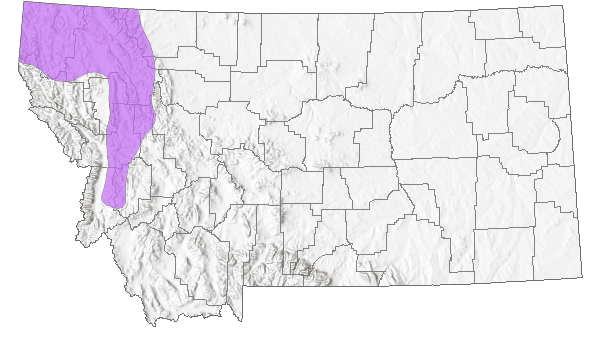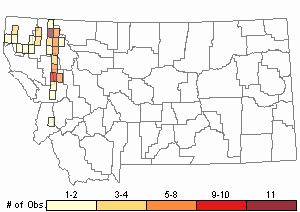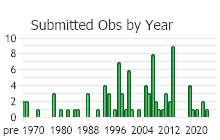View in other NatureServe Network Field Guides
NatureServe
Montana
Utah
Wyoming
Idaho
Wisconsin
British Columbia
South Carolina
Yukon
California
New York
Pod Grass - Scheuchzeria palustris
State Rank Reason (see State Rank above)
Known in Montana from several dozen fens west of the Continental Divide. Several locations are known only from historical surveys or collections, or from sites that need additional surveys to document the populations. The majority of populations are on National Forest lands with MT State Trust lands, private and National Park lands supporting the remaining occurrences. Populations are primarily vulnerable to activities that change the hydrology of the occupied fen and wetland habitats.
- Details on Status Ranking and Review
Population Size
Score0-1 - Moderate to Large: Population size is imprecisely known but is believed to be >10,000 individuals.
CommentTotal number of stems is likely greater than 100,000.
Range Extent
Score1 - Peripheral, Disjunct or Sporadic Distribution in MT: Widespread species that is peripheral, disjunct or sporadically distributed within MT such that it occurs in <5% of the state (<7,500 sq. miles or the combined area of Beaverhead and Ravalli Counties) or is restricted to 4-5 sub-basins.
Area of Occupancy
Score0 - High: Occurs in >25 Subwatersheds (6th Code HUC’s).
Environmental Specificity
Score2 - High: Species is restricted to a highly specialized and limited habitat and is typically dependent upon unaltered, high-quality habitat (C Values of 8-10).
Trends
Score0-1 - Stable to Minor Declines:
CommentTrends unknown, though populations are likely stable or experiencing only minor declines.
Threats
Score1 - Medium: 11-30% of the populations are being negatively impacted or are likely to be impacted by one or more activities or agents, which are expected to result in decreased populations and/or habitat quality and/or quantity.
Intrinsic Vulnerability
Score0-1 - Low to Moderate Vulnerability.
General Description
Perennial, rhizomatous herb. Stem ascending, 15–40 cm. Leaves alternate, terete, 5–35 cm long, erect with broad, sheathing bases. Inflorescence a several-flowered raceme with leaf-like bracts. Flowers perfect; tepals 6, greenish-white, 2–3 mm long; stamens 6; ovaries superior; pistils 3. Fruits 3, spreading, ovoid follicles, 5–8 mm long with 1 or 2 seeds each (
Lesica et al. 2012. Manual of Montana Vascular Plants. BRIT Press. Fort Worth, TX).
Phenology
Flowering in June, fruiting in July.
Diagnostic Characteristics
The sheathing, grass-like leaves and relatively large, 3-parted fruits are diagnostic. Pores at leaf tips, reduced upper leaves, and persistent remains of old leaves are also key features.
Species Range
Montana Range
Range Descriptions

 Native
Native
Range Comments
Circumboreal south to CA, ID, MT, IA and NJ (Lesica et al. 2012. Manual of Montana Vascular Plants. BRIT Press. Fort Worth, TX).
Observations in Montana Natural Heritage Program Database
Number of Observations: 103
(Click on the following maps and charts to see full sized version)
Map Help and Descriptions
Relative Density

Recency



 (Observations spanning multiple months or years are excluded from time charts)
(Observations spanning multiple months or years are excluded from time charts)
Habitat
Wet, organic soil of fens in the valley and montane zones, usually with Sphagnum moss.
Ecological Systems Associated with this Species
Stewardship Responsibility
Threats or Limiting Factors
STATE THREAT SCORE REASON
Reported threats to Montana's populations of Pod Grass include those that impact its wetland habitat (MTNHP Threat Assessment 2021). Management actions that divert or dam waters in the vicinity of Pod Grass habitat pose a risk to populations and permanent habitat loss. Reed Canarygrass (Phalaris arundinacea), known for the aggressive displacement of wetland habitat, is found in the vicinity of some populations. A few populations are found on private land owned by corporations, where the potential risk of land-use change is a concern.
References
- Literature Cited AboveLegend:
 View Online Publication
View Online Publication Lesica, P., M.T. Lavin, and P.F. Stickney. 2012. Manual of Montana Vascular Plants. Fort Worth, TX: BRIT Press. viii + 771 p.
Lesica, P., M.T. Lavin, and P.F. Stickney. 2012. Manual of Montana Vascular Plants. Fort Worth, TX: BRIT Press. viii + 771 p. MTNHP Threat Assessment. 2021. State Threat Score Assignment and Assessment of Reported Threats from 2006 to 2021 for State-listed Vascular Plants. Botany Program, Montana Natural Heritage Program, Helena, Montana.
MTNHP Threat Assessment. 2021. State Threat Score Assignment and Assessment of Reported Threats from 2006 to 2021 for State-listed Vascular Plants. Botany Program, Montana Natural Heritage Program, Helena, Montana.
- Additional ReferencesLegend:
 View Online Publication
View Online Publication
Do you know of a citation we're missing? Britton, N.L. 1909. North American Flora Part 1: pp41-42. Scheuchcariaceae. New York Botanical Gardens, New York, NY. A09BRI01PAUS
Britton, N.L. 1909. North American Flora Part 1: pp41-42. Scheuchcariaceae. New York Botanical Gardens, New York, NY. A09BRI01PAUS Bursik, R. J., and R. K. Moseley. 1992. Forty-year changes in Hager Lake Fen, Bonner County, Idaho. Cooperative Challenge Cost-share Project, Idaho Panhandle National Forests and Idaho Conservation Data Center, Idaho Department of Fish and Game, Boise. 31 pp.
Bursik, R. J., and R. K. Moseley. 1992. Forty-year changes in Hager Lake Fen, Bonner County, Idaho. Cooperative Challenge Cost-share Project, Idaho Panhandle National Forests and Idaho Conservation Data Center, Idaho Department of Fish and Game, Boise. 31 pp. Caicco, S. L. 1987. Field investigations of selected sensitive plant species on the Idaho Panhandle National Forest. Idaho Natural Heritage Program, Idaho Department of Fish and Game, Boise, Idaho. 44 pp.
Caicco, S. L. 1987. Field investigations of selected sensitive plant species on the Idaho Panhandle National Forest. Idaho Natural Heritage Program, Idaho Department of Fish and Game, Boise, Idaho. 44 pp. Cody, W.J. 1975. Scheuchzeria palustris L. (Scheuchzeriaceae) in northwestern North America. The Canadian Field-Naturalist 89: 69-71.
Cody, W.J. 1975. Scheuchzeria palustris L. (Scheuchzeriaceae) in northwestern North America. The Canadian Field-Naturalist 89: 69-71. Fernald, M. L. 1950. Gray's manual of botany. Eighth edition. A handbook of the flowering plants and ferns of the central and northeastern United States and Adjacent Canada. American Book Co., New York.
Fernald, M. L. 1950. Gray's manual of botany. Eighth edition. A handbook of the flowering plants and ferns of the central and northeastern United States and Adjacent Canada. American Book Co., New York. Gleason, H.A. 1952. New Britton & Brown. Illustrated Flora. Lancaster Press Inc. Lancaster, Pa. B52GLE01PAUS
Gleason, H.A. 1952. New Britton & Brown. Illustrated Flora. Lancaster Press Inc. Lancaster, Pa. B52GLE01PAUS Lesica, P., M.T. Lavin, and P.F. Stickney. 2022. Manual of Montana Vascular Plants, Second Edition. Fort Worth, TX: BRIT Press. viii + 779 p.
Lesica, P., M.T. Lavin, and P.F. Stickney. 2022. Manual of Montana Vascular Plants, Second Edition. Fort Worth, TX: BRIT Press. viii + 779 p. Linnaeus, C. 1753. Species Plantarum. A fascimile of the first edition printed by Adlard & Son, Bartholomew Press, Dorking, Great Britain. 2 vol.
Linnaeus, C. 1753. Species Plantarum. A fascimile of the first edition printed by Adlard & Son, Bartholomew Press, Dorking, Great Britain. 2 vol. McCance, R.M., Jr., and J.F. Burns, eds. 1984. Ohio endangered and threatened vascular plants: Abstracts of state-listed taxa. Division Natural Areas and Preserves, Ohio Dept. Natural Resources, Columbus. 635 pp.
McCance, R.M., Jr., and J.F. Burns, eds. 1984. Ohio endangered and threatened vascular plants: Abstracts of state-listed taxa. Division Natural Areas and Preserves, Ohio Dept. Natural Resources, Columbus. 635 pp. Moseley, R. K., R. J. Bursik, and M. Manusco. 1991. Floristic inventory of wetlands in Fremont and Teton counties, Idaho. Unpublished report on file IDCDC Department of Fish & Game, Boise, ID. 60 pp.
Moseley, R. K., R. J. Bursik, and M. Manusco. 1991. Floristic inventory of wetlands in Fremont and Teton counties, Idaho. Unpublished report on file IDCDC Department of Fish & Game, Boise, ID. 60 pp. Rumely, J. H. 1956. Plant ecology of a bog in northern Idaho. Unpublished dissertation, Washington State University, Pullman. 85 pp.
Rumely, J. H. 1956. Plant ecology of a bog in northern Idaho. Unpublished dissertation, Washington State University, Pullman. 85 pp. Slack, N. G., D.H. Vitt, and D.G. Horton. 1980. Vegetation gradients of minerotrophically rich fens in western Alberta. Canadian Journal of Botany 58: 330-350.
Slack, N. G., D.H. Vitt, and D.G. Horton. 1980. Vegetation gradients of minerotrophically rich fens in western Alberta. Canadian Journal of Botany 58: 330-350. Voss, E.G. 1972. Michigan Flora Part I. Kingsport Press, Bloomfield Hills, Mich. B72VOS01PAUS
Voss, E.G. 1972. Michigan Flora Part I. Kingsport Press, Bloomfield Hills, Mich. B72VOS01PAUS
- Web Search Engines for Articles on "Pod Grass"





